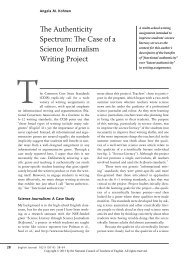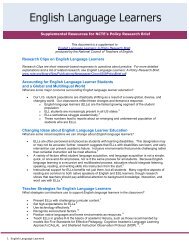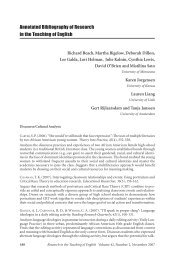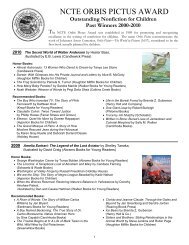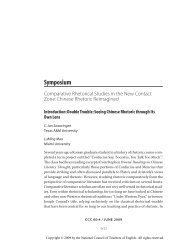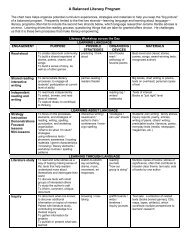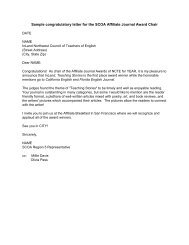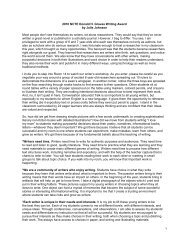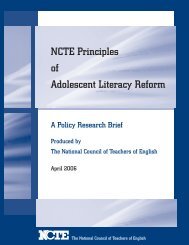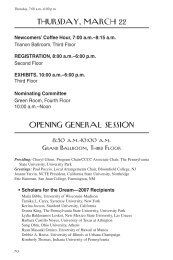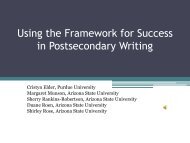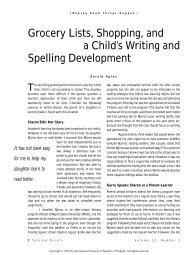Annotated Bibliography of Research in the Teaching of English
Annotated Bibliography of Research in the Teaching of English
Annotated Bibliography of Research in the Teaching of English
- No tags were found...
You also want an ePaper? Increase the reach of your titles
YUMPU automatically turns print PDFs into web optimized ePapers that Google loves.
<strong>Annotated</strong> <strong>Bibliography</strong> 235cognitive learn<strong>in</strong>g tool <strong>in</strong> terms <strong>of</strong> (1) content analysis <strong>of</strong> <strong>the</strong> onl<strong>in</strong>e discussion through a dialogicalframework for social modes <strong>of</strong> th<strong>in</strong>k<strong>in</strong>g to measure social reason<strong>in</strong>g, and (2) keywordidentification and concept mapp<strong>in</strong>g connectivity to measure conceptual transfer from <strong>the</strong> onl<strong>in</strong>ediscussion to <strong>in</strong>dividual students and higher-order th<strong>in</strong>k<strong>in</strong>g. Triangulation <strong>of</strong> data shows thatstudents us<strong>in</strong>g an onl<strong>in</strong>e discussion forum <strong>in</strong>crease <strong>the</strong> <strong>in</strong>cidence <strong>of</strong> exploratory talk, broaden<strong>the</strong>ir knowledge <strong>of</strong> global citizenship concepts, transfer conceptual knowledge from <strong>the</strong> discussionto <strong>the</strong> <strong>in</strong>dividual, and use higher-order th<strong>in</strong>k<strong>in</strong>g. The study establishes that critical learn<strong>in</strong>gtakes place through us<strong>in</strong>g a collaborative onl<strong>in</strong>e discussion forum and f<strong>in</strong>ds that <strong>the</strong> dialogicalframework for social modes <strong>of</strong> th<strong>in</strong>k<strong>in</strong>g and concept mapp<strong>in</strong>g based on <strong>in</strong>formationand communication technologies provide useful evaluation tools to identify components <strong>of</strong>critical learn<strong>in</strong>g.REINHEIMER, D. A. (2005). Teach<strong>in</strong>g composition onl<strong>in</strong>e: Whose side is time on? Computers andComposition, 22(4), 459-470.Compares <strong>the</strong> amount <strong>of</strong> time required to teach a face-to-face versus three onl<strong>in</strong>e sections <strong>of</strong><strong>the</strong> same composition course. F<strong>in</strong>ds that teach<strong>in</strong>g composition onl<strong>in</strong>e takes almost twice asmuch time as face-to-face teach<strong>in</strong>g due to differences <strong>in</strong> <strong>in</strong>itial course development, k<strong>in</strong>ds <strong>of</strong><strong>in</strong>structional designs required, socialization <strong>of</strong> students to onl<strong>in</strong>e learn<strong>in</strong>g, and differences <strong>in</strong>students’ learn<strong>in</strong>g preferences.O<strong>the</strong>r Related <strong>Research</strong>:BEAVIS, C., & CHARLES, C. (2005). Challeng<strong>in</strong>g notions <strong>of</strong> gendered game play: Teenagers play<strong>in</strong>gThe Sims. Discourse, 26(3), 355-367.BOLICK, C. M. (2006). Digital archives: Democratiz<strong>in</strong>g <strong>the</strong> do<strong>in</strong>g <strong>of</strong> history. International Journal<strong>of</strong> Social Education, 21(1), 122-134.BUCKINGHAM, D., & WILLETT, R. (EDS.). (2006). Digital generations: Children, young people, and<strong>the</strong> new media. Mahwah, NJ: Erlbaum.BURNETT, C., DICKINSON, P., MYERS, J., & MERCHANT, G. (2006). Digital connections: Transform<strong>in</strong>gliteracy <strong>in</strong> <strong>the</strong> primary school. Cambridge Journal <strong>of</strong> Education, 36(1), 11-29.CHÁVEZ, V., & SOEP, E. (2005). Youth radio and <strong>the</strong> pedagogy <strong>of</strong> collegiality. Harvard EducationalReview, 75(4), 409-434.CHOI, I., LAND, S. M., & TURGEON, A. J. (2005). Scaffold<strong>in</strong>g peer-question<strong>in</strong>g strategies to facilitatemeta-cognition dur<strong>in</strong>g onl<strong>in</strong>e small group discussion. Instructional Science: An InternationalJournal <strong>of</strong> Learn<strong>in</strong>g and Cognition, 33(5-6), 483-511.COFFEY, A., RENOLD, E., DICKS, B., SOYINKA, B., & MASON, B. (2006). Hypermedia ethnography <strong>in</strong>educational sett<strong>in</strong>gs: Possibilities and challenges. Ethnography & Education, 1(1), 15-30.CROSS, B. (2005). Split frame th<strong>in</strong>k<strong>in</strong>g and multiple scenario awareness: How boys’ game expertisereshapes possible structures <strong>of</strong> sense <strong>in</strong> a digital world. Discourse, 26(3), 333-353.DE VRIES, B., VAN DER MEIG, H., BOERSMA, K. T., & PIETERS, J. M. (2005). Embedd<strong>in</strong>g e-mail <strong>in</strong>primary schools: Develop<strong>in</strong>g a tool for collective reflection. Journal <strong>of</strong> Educational Comput<strong>in</strong>g<strong>Research</strong>, 32(2), 167-183.DE WEVER, B., SCHELLENS, T., VALCKE, M., & VAN KEER, H. (2006). Content analysis schemes toanalyze transcripts <strong>of</strong> onl<strong>in</strong>e asynchronous discussion groups: A review. Computers & Education,46(1), 6-28.DICKEY, M. D. (2005). Engag<strong>in</strong>g by design: How engagement strategies <strong>in</strong> popular computer andvideo games can <strong>in</strong>form <strong>in</strong>structional design. Educational Technology <strong>Research</strong> and Development,53(2), 67-83.DOBSON, T., & LUCE-KAPLER, R. (2005). Stitch<strong>in</strong>g texts: Gender and geography <strong>in</strong> Frankenste<strong>in</strong>and Patchwork Girl. Chang<strong>in</strong>g <strong>English</strong>, 12(2), 265-277.ELLIS, R. A. (2006). Investigat<strong>in</strong>g <strong>the</strong> quality <strong>of</strong> student approaches to us<strong>in</strong>g technology <strong>in</strong> experiences<strong>of</strong> learn<strong>in</strong>g through writ<strong>in</strong>g. Computers & Education, 46(4), 371-390.



